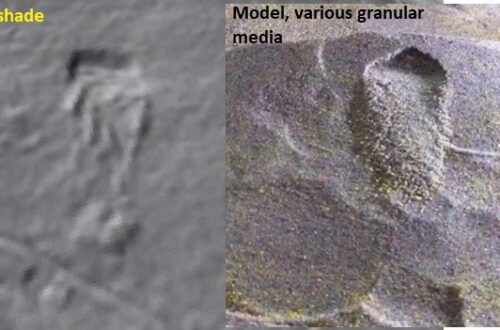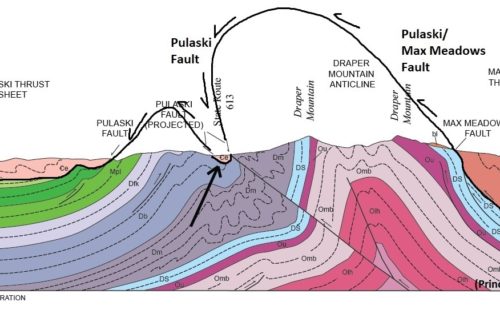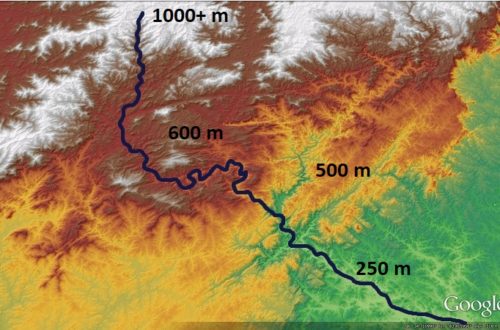An Abandoned River Valley and the “True Depth” of Appalachia’s Deepest River Gorge
by Philip S. Prince, Virginia Tech Active Tectonics and Geomorphology Lab
In the last “Deepest Gorge” post, I said the depth of the North Carolina’s Nantahala Gorge could be measured as either 3200 ft (975 m) or 800 ft (243 m). The big difference between these numbers results from distinguishing between background topography and a specific gorge-forming event within that topography. I like the 800 ft figure because it speaks to a measurable episode of gorge deepening that can be tied to a specific geologic cause. The Nantahala Gorge is actually one of the best places on the east coast to see how a geologist can use landforms to pick out and measure a gorge-deepening episode (the 800 ft) within an already rugged, high relief “background” landscape (the additional 2400 ft). This post centers around an oddly meandering, dry valley 800 ft above the northwest wall of the gorge (outlined in yellow below). It’s not much to look at in Google Earth imagery alone, but with enhanced maps and some understanding of how river gorges spread through topography, it gives great context for different ways of thinking about gorge development.
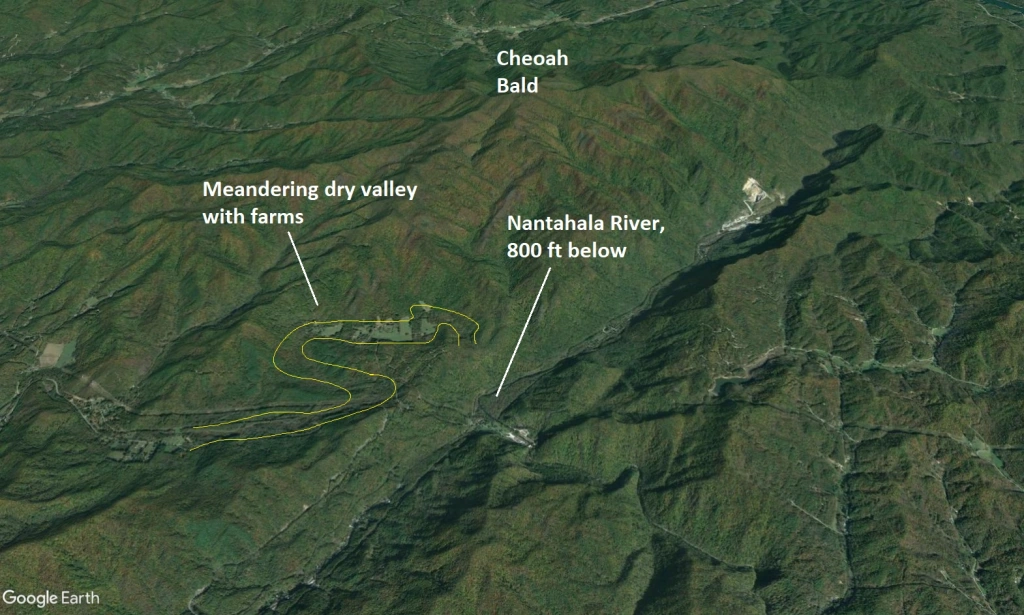
As a geologist, I associate gorges with a scenario in which river downcutting has become notably faster than the evolution of the surrounding landscape. This results in rapids and falls efficiently carving narrow, steep-sided gorges in rivers and their largest tributaries while the rest of the landscape waits for the downcutting to spread through smaller tributary streams. An interesting consequence of this lag between river and large-scale landscape response is the survival of old topographic features that end up temporarily “perched” above the newly carved gorges before they are consumed by the spreading wave of erosion. The old river channel in the GIF below is an example.

The old abandoned river channel is clearly of river origin (perhaps the meandering valley in the first photo also has a river-like shape?), and is a nice marker for the general elevation of the river system before it began carving into the landscape more quickly. As the active river carves its gorge, the old channel ends up stranded higher and higher above the active river as the gorge grows deeper. As the steep walls of the gorge begin to spread outward into the landscape, they gradually chew away at the old channel, but parts of it continue to survive as a reminder of the pre-gorge river elevation. Geologists look for features like the old channel (they ain’t always this obvious) to understand the history of river downcutting throughout entire drainage networks as shown below. 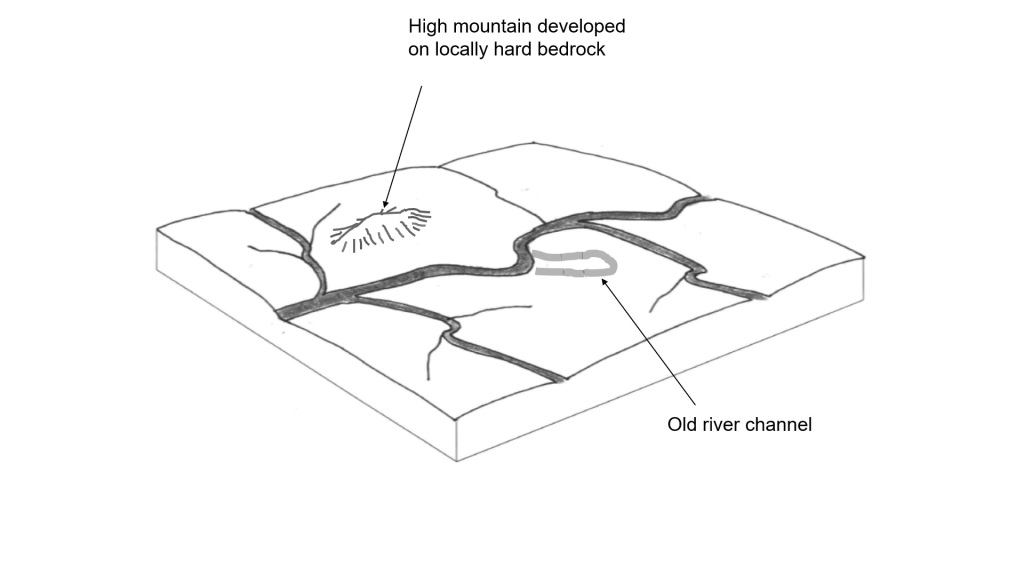

While the little scrap of old river channel is an unimpressive landscape feature, it is very useful in improving specific understanding of how the river system is shaping the landscape. By comparing its elevation to the upstream limits of gorges in river tributaries, it is possible to reconstruct the pre-gorge landscape (top image) and keep the apparently huge gorge depth at the foot of the high mountain in context. This shockingly deep portion of the gorge can be identified for what it really is–a modestly deep gorge carved into a pre-existing area of unusually high and steep topography developed on hard bedrock (like Cheoah Bald above the Nantahala).
So, if you can just find some sort of pre-downcutting marker in the landscape surrounding a real gorge system, you can 1) see a specific amount of river downcutting within the “noise” of pre-existing topography, 2) possibly connect downcutting to a geologic cause, 3) enhance understanding of the landscape and how to best interact with it, and 4) show that geomorphology studies are worthwhile, etc. etc. Because all parts of the Appalachian landscape are constantly changing (even if more slowly than river valleys), finding identifiable old topographic markers above gorge systems is tough and often impossible. It gets easier with colored digital elevation models that show only landforms and elevation without the distraction of actual land cover (like the GIF below). Old, subtle landforms often become visible in these maps, and the meandering dry valley 800 ft above the Nantahala is a good example.

The Nantahala River is marked in blue in the image below; it flows from the white high elevation areas at the bottom of the image towards the top. The river enters the deepest part of the Nantahala Gorge where it makes its abrupt, 90-degree turn to the northeast; the Nantahala Cascades are just down and right (upstream) of the 90-degree turn. The meandering dry valley is immediately up and left of the 90-degree turn. If you train your eye, you may be able to pick it out (it’s gray to light brown).
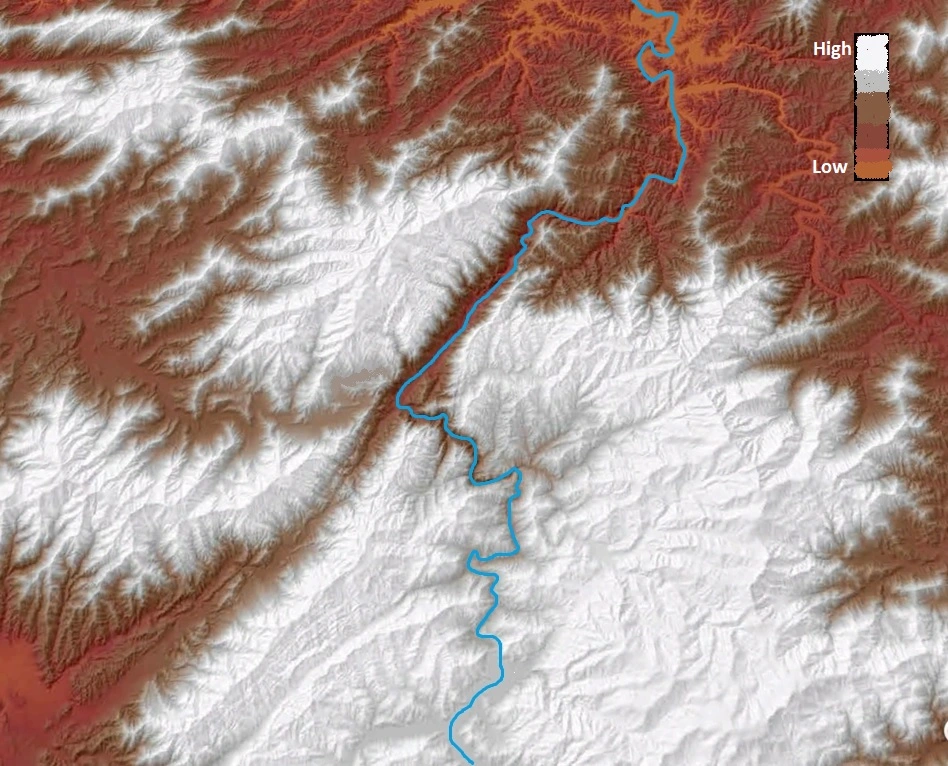
This is where it gets good. If you look at the image above or the zoomed image below, you might be able to imagine the river not making the 90-degree turn and just continuing right on through the meandering valley. This is indeed what used to happen, but the meandering dry valley is now 800 ft above the modern Nantahala. It is still very recognizable as a river valley, albeit a mostly dry one, and its elevation fits well with the upper end of a zone of rapids that has migrated up the Nantahala (the Cascades) from the 90 degree bend. Just like the cartoon model a few images back, this “perched” remnant river valley is a nice marker of the where the river used to be before it carved the last 800 ft of gorge in association with the major change in its course. Because the remnant valley has not been eroded away or completely buried in sediment, it is safe to say that the last 800 ft of Nantahala Gorge development have happened quickly compared to the rate at which much of the surrounding landscape is changing.
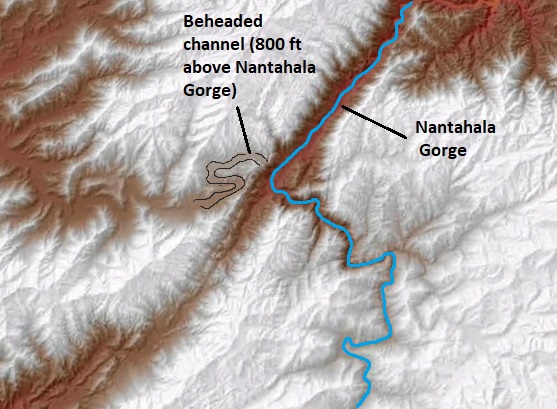
So what does the 90 degree turn have to do with gorge development, and why do I call the meandering valley a “beheaded channel?” Like many Appalachian rivers with gorges, the Nantahala is a victim of stream capture. If neighboring river systems have very different elevations, the outer tributaries of the lower system tend to erode their way into the higher system. This leads to natural diversion, or capture, of the elevated rivers into the lower valley network. The Nantahala and its tributaries are hundreds of feet higher than the neighboring Little Tennessee system, setting them up to be capture victims. As crudely illustrated below, a little Tennessee tributary ate its way through soft rocks in the Murphy Syncline and intersected the old Nantahala, capturing it. This produced the 90 degree bend, caused the 800 ft of downcutting as the Nantahala carved down to match Little Tennesee elevation, and “turned off the water” to the valley below the capture point. Because the now (mostly) dry stream valley no longer has headwaters to supply it, it is described as “beheaded.”

The whole point of using the Nantahala example is to show the value of taking a closer look at the overall geologic context of landscape superlatives (highest, deepest, etc.). While only 800 ft of the 3200 ft of gorge topography relates to the geologically recent downcutting, these 800 ft occurred at a rate faster than the evolution of the surrounding landscape, and can be viewed as “undercutting” the already steep mountain topography and its 2000+ ft of topographic relief. This undercutting has set the stage for regular landsliding, which is an expression of the landscape around the gorge trying to catch up to the Nantahala and better match its new elevation and course to the Little Tennessee. Many of the “deepest gorge” candidates from the previous blog also experience regular landsliding for the same reason–they represent recently excavated topography that is in a phase of adjustment to a newly lowered river elevation. The majority of the “deepest” candidates are also clearly stream capture-related, meaning their development is river system-specific and may not necessarily reflect what is going on throughout the entire Appalachian range.
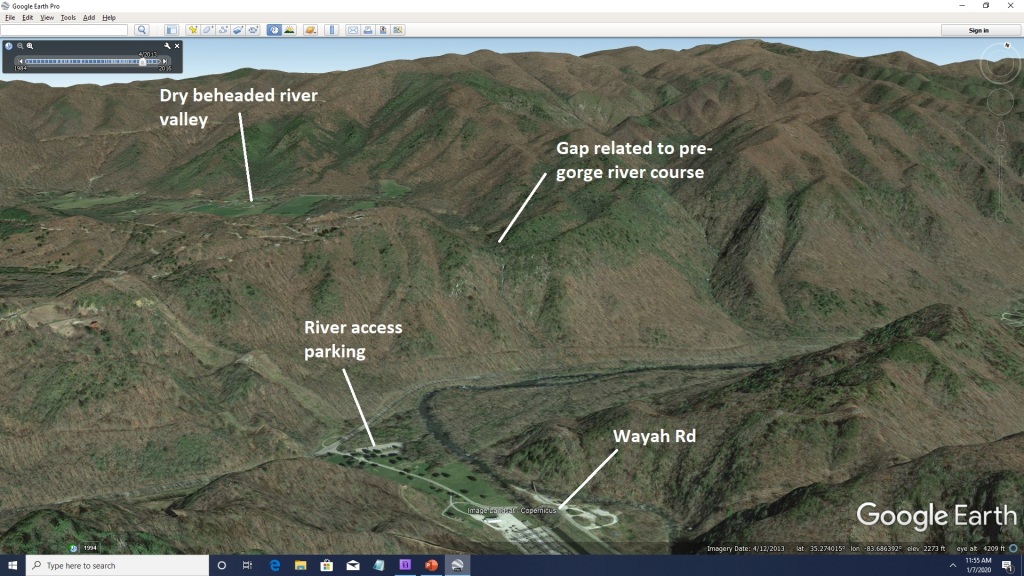
I have not spent much time around the Nantahala, but I think it would be possible to see some evidence of the pre-gorge river elevation from river level. Standing near the Wayah Road bridge over the river and looking downstream (see above), a gap in the north wall of the gorge might be visible from the road or adjacent fields. This gap is where the pre-gorge, pre-capture river flowed, although the gap has been lowered somewhat by erosion spreading outward from the gorge. If you were looking up at this gap, you would have to visualize the old Nantahala flowing 800 ft above you, atop bedrock which has been carved out by erosion and transported downstream!
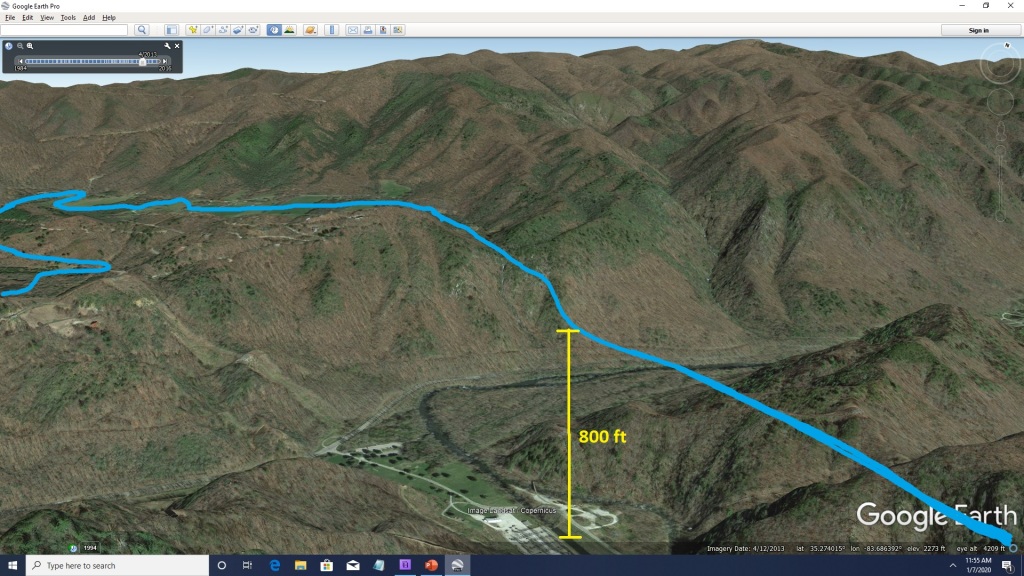
While the colored DEM is the best way to see the old Nantahala course preserved at the lip of the gorge, it is somewhat visible in Google Maps using the Terrain function (go to 35.282750N 83.690604W). I have faintly outlined the valley in the image below.

While the valley is surprisingly well-preserved, it is being attacked by erosion from the Nantahala Gorge. The tiny stream draining its east end to the Nantahala drops over an impressive waterfall as it descends the 800 ft to the river. The remainder of the valley that still drains to the west has been filled in to some extent by sediment being shed from the steep hillslopes above it. The low slope of the valley is consistent with a good-sized river (the old Nantahala) flowing through it; the river would have had enough water to efficiently move the sediment supplied to it. Now that capture has turned the water off, the sediment just piles up because the tiny creek in the valley certainly can’t transport it with its low flow and low gradient. Even in its beheaded state, the valley goes to show that no spot in the landscape is completely protected from change over time.
Interestingly, geology seek to identify “pre-gorge” landscapes in settings around the world to try to determine how much rivers have carved into the landscape and why. A particularly cool application of the technique is its use to try to connect focused uplift in mountain ranges with moving faults miles deep in the earth and associated earthquake hazard. This paper is a good example, and this post tries to illustrate the concept with a sand model.

